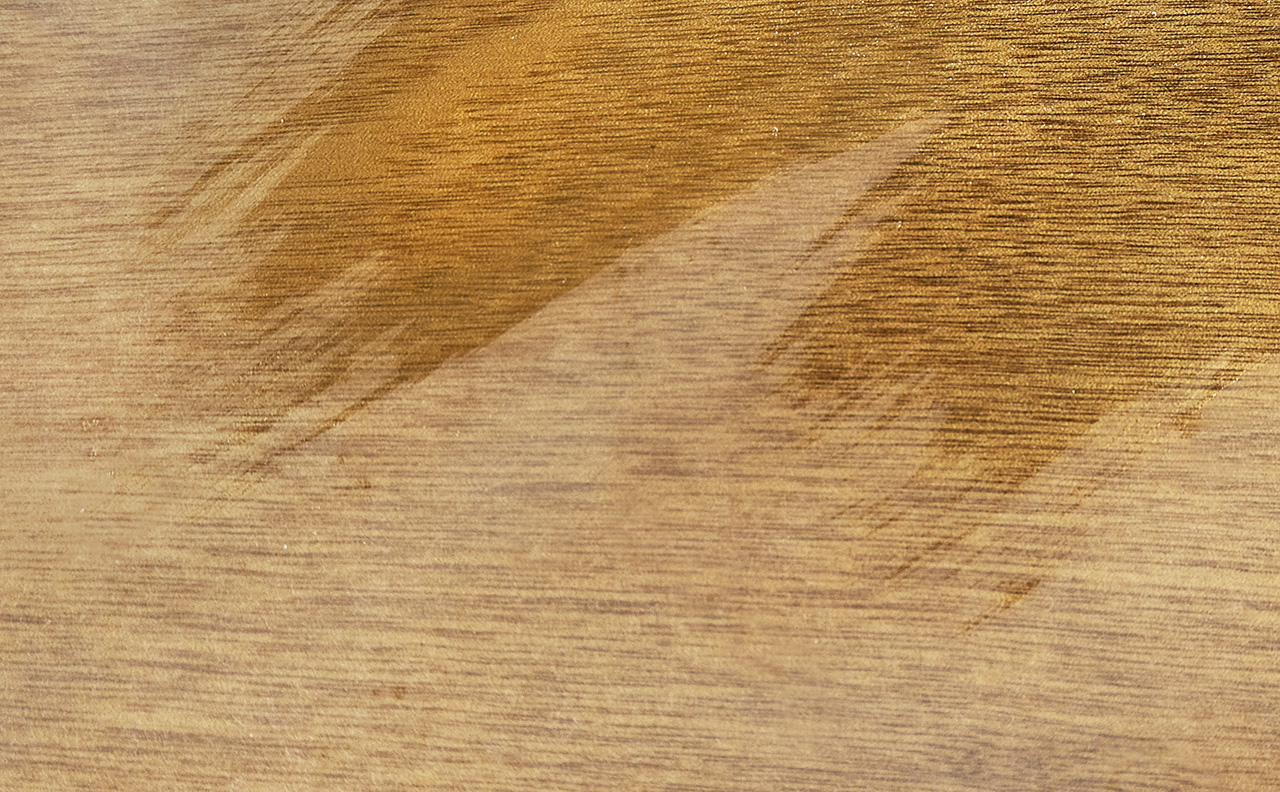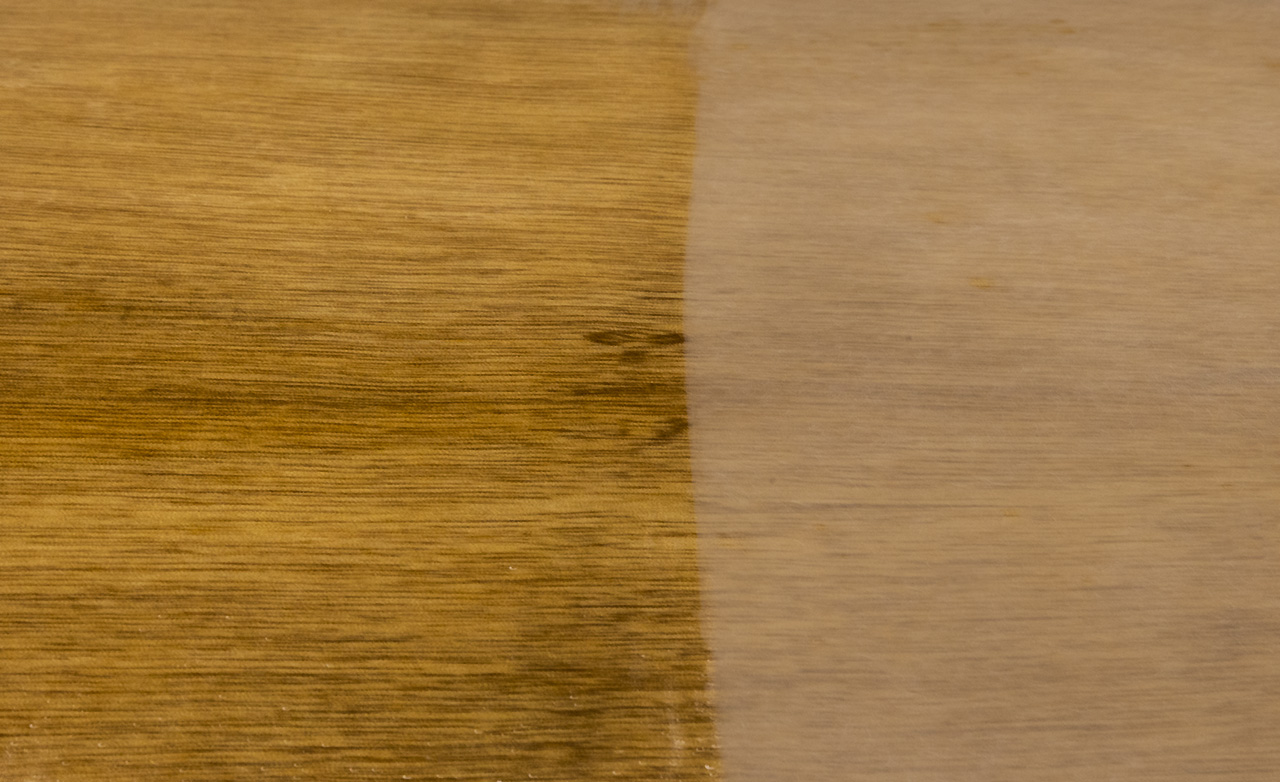I attacked the aft deck with the orbital sander and 80 grit pads, went over it again with 220 pads and then with ScotchBrite (just because), wiped it down with a fresh tack cloth, and then applied varnish using a small foam brush. “Wet edges, anyone?”
This small deck will be a laboratory for how much sanding is apt. How rough is too rough, what texture insures the varnish’s grip, and how much varnish covers how much wood. It will be nice if such aggressive sanding can relieve the last of the uneven epoxy coat introduced ages ago by my unwise application of stain and if the varnish can then restore the finish. [Respectively: it does help, and yes it can.]

I feel licensed to proceed with varnishing while skipping the full clean-room treatment because I am almost certain that the final finish will be satin or matte and therefore much more forgiving than a to-die-for gloss. And I am 100% sure that if things go south at any time in this process, another chance can be mine after some Zen-rich time sanding and another coat of varnish.
I’m using Epifanes RapidClear and should be able to apply a second coat in 5-6 hours. It’s still a little cool down there (~62F), so that might be slightly optimistic.
The first coat was dry and tack free after six hours, as promised, so I did as Epifanes says I can and applied a second coat to the after deck without sanding the first. I’d say it’s looking pretty good, but the varnish is still wet.
Day 100
After drying overnight, the varnish on the aft deck was hard enough to be unlikely to swallow saw- or epoxy dust. It felt solid and was certainly set sufficiently for me to cover it with with carpet squares. So I did that and then sanded the foredeck. There, I finally burned into the plywood while trying to level a bit of stubborn infelicity. Then I varnished both decks and the interior. Here’s a photo of the first coat going on on the forward deck.

The burned-through bit was not merely improved by the varnish; it was all but hidden. I can still feel it as a subtle depression. The reflectivity in that spot is a little different, but the color is fine. Let’s call it “healed” or at least “healing” and carry on. I used ScotchBrite between coats 2 and 3 in the back just to see if it made any difference. [Not really; it certainly didn’t hurt and might’ve helped a bit.]
About six hours after applying the noon-time coat, I applied another. So that’s four coats in the back and two up front and in the interior. This evening, the most recent coat remained very slightly tacky — I must have laid it on a little heavy. My experience applying one coat over a slightly tacky surface suggests it would be better to wait a little longer. All is well, but when applied over a less-than-reasonably-dry surface the varnish did not flow as nicely as it might have. As of 11:30 PM, the coat is not completely set, so I’m going to let things rest at least until tomorrow morning before continuing.
As of now, this boat is officially beautiful.
Day 101
Another day, another coat. Just after noon, I lightly ScotchBrited both decks and the bulkheads before applying another layer of RapidClear. I imagined that that would do it for the aft deck, but some side to side striations showed up. So when I went down to do one more coat up front, I applied another in the back as well. I was careful to apply and then tip out this coat with mostly longitudinal strokes. I doubt it will matter with the lightest of ScotchBrite passes. This time for sure. Tomorrow, I’ll flip the boat over and try to get two coats on the hull. After two more on Sunday, the woodwork will be done.
Day 102
I went all Poseidon Adventure with the boat. The hull wasn’t beset with the ill-advised stain ages ago, so the epoxy was much smoother than on the decks. I admired it before roughing it up with the orbital sander and 80 grit pads. It took three pads to scuff it up from stem to stern.
That “what have I done?” moment lasted only until the first brush stroke. Epifanes QuickClear worked like a charm from the first touch. Grain and color came right back. For the record, it took 53g to coat the hull. I applied it lightly because I don’t want runs on these steep sides, and I certainly don’t want little varnish stalagtites taking form at the edges of the deck. I was probably too generous with the deck coats. I might have enough left for four coats of the hull, or maybe three. If I only get two, I’ll remember that the hull does not get the sun-exposure that the deck does and will add more by and by.
After five and a half hours, I used ScotchBrite to make sure I had at least some mechanical grip for the next layer of varnish and then laid down a second coat. I thought I was being just as abstemious with this one, but in fact I used almost twice as much (92 grams). How? Why? Was it just because without more thorough sanding I couldn’t tell when coverage was complete? Or is something more subtle going on? I might be enough left for a third coat tomorrow. I could use traditional marine varnish that I’ve had on the shelf for 13 years — I have plenty of that — but, well, I’ve had it on the shelf for 13 years. Who knows how it would behave? Also, it takes much longer that RapidClear to cure, and it’s a different final surface, so, for various reasons, I’m not going that route, at least not right away. (I have got to stop saying things like that. Keep reading.)
I’m shopping up water shoes. I was going to cannibalize some to make stretchers, but now I think I’ll use them as… water shoes and cobble up something else (literally) for the stretchers.
Day 103
Of course, I couldn’t resist. Since I was running short of Epifanes RapidClear after just two coats on the hull but was blessed with an abundance of Interlux Schooner Gold, I applied a layer of God’s own varnish over a ScotchBrite roughed, day-old Epiphanes semi-gloss. After all this, I at least wanted to know the difference. It’s not subtle! Real varnish is thick as paste by comparison. No wonder people talk about thinning it. I applied what I believed was a modest coat, just being sure to cover, and when I finished, I discovered that I had applied 194 grams to the hull. I went back to intercept runs and sweep up pools. I wouldn’t have tried this if I didn’t expect to be preoccupied with other projects until Tuesday evening (45-48 hours from now). If it is not hard by then, I will try not to panic. More when I know more.
This doesn’t deserve its own day, but 48 hours after laying Interlux Schooner Gold on the hull, the basement (aka, the boatyard) is flooded with a heavy, not unpleasant but definitely distinctive and pervasive oily aroma. Ah, varnish! Important for anyone building in tight quarters: this is the only odor I associate with any process so far. It has not reached the rest of the house, by which I mean not only that I cannot smell it up here, but Amy can’t, and that is a much more stringent test.